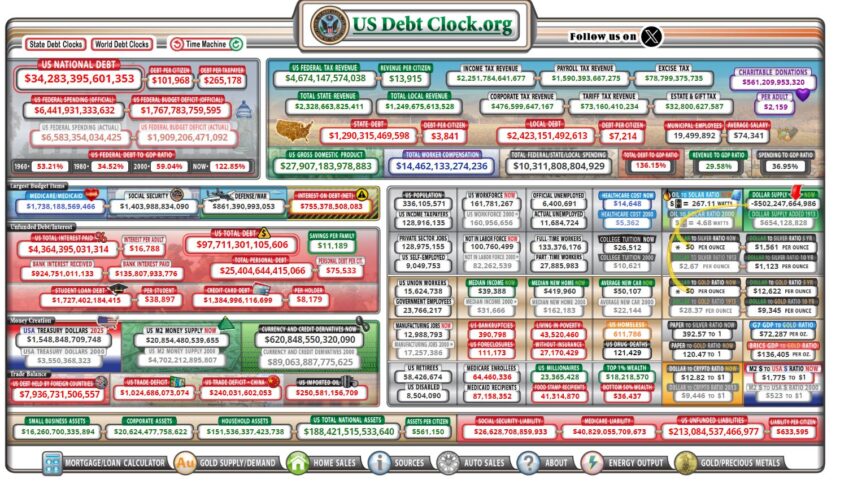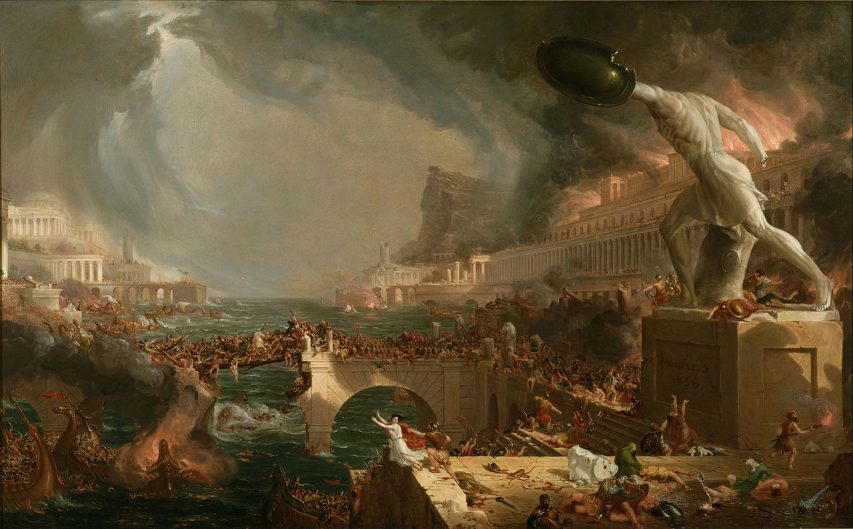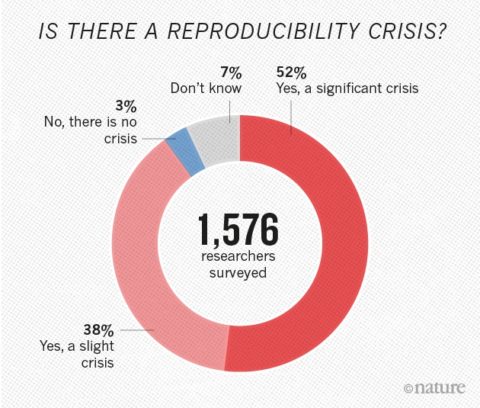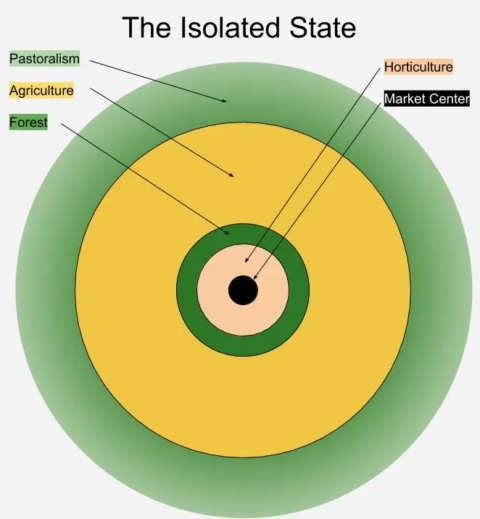The Great War
Published Nov 10, 2023Germany’s defeat in the First World War has been blamed on all kinds of factors or has even been denied outright as part of the “stab in the back” myth. But why did Germany actually lose?
(more…)
February 28, 2024
Why Germany Lost the First World War
February 27, 2024
Javier Milei gets ghosted by US media after posting rare budget surplus in Argentina
Jon Miltimore on Argentine President Javier Milei’s good economic news that the legacy US media are resolutely ignoring:

Argentine President Javier Milei speaking at the World Economic Forum gabfest in Davos, Switzerland, January 2024.
Photo by Flickr – World Economic Forum | CC BY-NC-SA 2.0
Argentines witnessed something amazing last week: the government’s first budget surplus in nearly a dozen years.
The Economy Ministry announced the figures Friday, and the government was $589 million in the black.
Argentina’s surplus comes on the heels of ambitious cuts in federal spending pushed by newly-elected President Javier Milei that included slashing bureaucracy, eliminating government publicity campaigns, reducing transportation subsidies, pausing all monetary transfers to local governments, and devaluing the peso.
Milei’s policies, which he has himself described as a kind of “shock therapy,” come as Argentina faces a historic economic crisis fueled by decades of government spending, money printing, and Peronism (a blend of national socialism and fascism).
These policies have pushed the inflation rate in Argentina, once one of the most prosperous countries in Latin America, above 200 percent. Today nearly 58 percent of the Argentine population lives in poverty, according to a recent study.
And Milei rightfully blames Argentina’s backward economic policies for its plight — policies that, he points out, are spreading across the world.
“The main leaders of the Western world have abandoned the model of freedom for different versions of what we call collectivism,” Milei said in a recent speech in Davos. “We’re here to tell you that collectivist experiments are never the solution to the problems that afflict the citizens of the world — rather they are the root cause.”
The revelation that Argentina has done something the US government hasn’t done in more than two decades — run a budget surplus — seems like a newsworthy event.
Yet to my surprise, I couldn’t find a word about it in major US media — not in the New York Times, the Associated Press, the Washington Post, or Reuters. (The New York Sun seems to be the only exception.)
I had to find the story in Australian media! (To be fair, the Agence France Presse also reported the story.)
One could argue that these outlets just aren’t very interested in Argentina’s politics and economics, but that’s not exactly true.
The Associated Press has covered Argentinian politics and Milei extensively, including a recent piece that reported how the new president’s policies were inducing “anxiety and resignation” in the populace. The same goes for Reuters and the other newspapers.
A cynic might suspect these media outlets simply don’t wish to report good news out of Argentina, now that Milei is president.
The Company that Broke Canada
BobbyBroccoli
Published Nov 4, 2023For a brief moment, Nortel Networks was on top of the world. Let’s enjoy that moment while we can. Part 1 of 2.
00:00 This is John Roth
02:04 The Elephant and the Mouse
12:47 Pa without Ma
26:27 Made in Amerada
42:15 Right Turns are Hard
57:43 Silicon Valley North
1:07:37 The Toronto Stock Explosion
(more…)
QotD: The role of the scholar
The first Great Commandment of scholarship is be honest; everything else is commentary. All the standards and methods that scholars have developed over the ages can be reduced to “be honest”.
Of course, fraudulent scholars have always existed, but it seems to me — not that I’ve conducted a study of the matter — that clear dishonesty by leading scholars no longer elicits widespread condemnation and no longer discredits the guilty parties to the extent that it used to. The Nancy MacLean affair [her book Democracy in Chains (2017) was an extended character assassination of Nobel Prize winning economist James M. Buchanan] is clear-cut. Thomas Piketty’s work is either blatantly dishonest or spectacularly incompetent. And many other examples might be adduced. Ideology, it seems, has overwhelmed scholars in the humanities and social sciences to an unprecedented degree.
Scholars should be seeking the truth, the whole truth, and nothing but the truth, however much they appreciate that this objective can never be attained fully. They are obliged to strive. If they clearly are not trying, indeed, are twisting and turning in the ideological wind above all, real scholars should drum them out of their professions as unworthy of recognition by genuine scholars.
Bob Higgs, Facebook, 2019-08-28.
February 26, 2024
The Freedom Convoy’s European echoes
Niccolo Soldo on the widespread protests against the EU and various national governments’ intrusive and anti-human attempts to restrict or destroy European farmers in pursuit of their climate change agenda:
I wish there was a way to measure the gulf between ruling elites and the people that they lord over. Don’t Political Scientists have such a methodology already on hand? I don’t know.
What I do know is that this gulf is very palpable on both sides of The Pond, and that this gulf shows no signs of narrowing any time soon. Whether the issue is migration, crime, COVID-19, etc., it seems that the views of the people are simply ignored by those who can and do ignore them, and proceed to make policy that suits their own interests and the interests of their allies and class.
Judging by American media reporting, you would most likely not be aware that massive farmers’ protests are rocking the European continent as we speak. From Portugal to Poland, farmers are protesting the EU’s drive to push policies like “Net Zero” in order to “combat Climate Change” … policies that would severely impact the livelihoods of our food producers. These proposed changes are entirely top-down, indicative of just how divorced the Brussels elites are from the daily lives of the people whose lives they wish to upend with a stroke the pen. “Oppose us? You must be far right … probably a Nazi too.”
The “far-right” political libel against hard-pressed farmers is really a sign of how far the EU elites have lost touch with the reality of life for the peoples of Europe. We should ignore the slurs, and get behind the fighting farmers.
The protests by angry farmers have spread across the European Union, with mighty convoys of tractors blockading roads and cities from Romania to Rome, from Portugal to Poland, from Bulgaria to Brussels and beyond.
There might be some national variations in the farmers’ specific demands. But what unites them all is opposition to the way that the EU elites are subordinating agricultural policy to their Green agenda and Net Zero obsession, leading to more hardship for farmers and higher food prices for other Europeans.
As tractor convoys blockaded German cities in January, farmers’ association president Joachim Rukwied spelt out that they were protesting not just against the government’s proposed cuts in fuel subsidies, but against an EU-wide system where “agricultural policy is being made from an unworldly, urban bubble and against farming families and rural areas”.
This week in Poland, 62-year-old protesting farmer Janusz Bialoskorski told the media that, “They’re talking about climate protection. But why should it be done at farmers’ expense?” Farmers, he pointed out, are not responsible for industrial pollution, and “nor do we fly to Davos on our jets”.
Pitchfork Populism. The fact that the elites in Brussels have invited this in a year when elections for the EU’s Parliament are scheduled to occur indicates just how out of touch they really are.
These farmers are now in the front line of a wider populist revolt, against those elitists who DO fly in their private jets to the World Economic Forum in luxurious Davos, Switzerland, where they lecture the rest of us about how to save the planet by sacrificing our living standards.
Their protests expose the yawning gap between the high-minded talk of the Brussels Green oligarchy, and the grim reality of what those Net Zero policies mean for normal people in the muddy fields of Flanders or on the supermarket shelves of Florence.
If you can’t shut them up, call them “far right”:
Last weekend, UK Observer newspaper (Sunday sister of the liberal Guardian), the most pro-EU voice in the British media, worried aloud about how the European farmers’ cause “has been enthusiastically adopted by a resurgent populist far-right”.
Similar fears have repeatedly been expressed in the Brussels-backing news media this year: “Brussels struggles to placate farmers as far-right stokes protests,” and “EU farmers egged on by the far-right” (Financial Times); “How the far-right aims to ride farmers’ outrage to power in Europe” (Politico); “Far-right harvests farmers’ anger across Europe” (France 24) etc., etc.
The EU establishment and its media pals are so out of touch with the reality of people’s lives that they apparently imagine Europe’s naïve farmers are protesting only because they have been “egged on” or “stoked up” by “far-right” agitators. The idea that these farmers might be entirely reasonable, hard-working people who are simply at the end of their collective tether with EU bureaucracy seems beyond the comprehension of those bureaucrats and their media mouthpieces.
“A Silent War on Farming”:
As the title of a recent report by the think-tank MCC Brussels puts it, Europe’s agricultural communities are facing nothing less than a “Silent War on Farming,” waged from Brussels.
For decades, EU agricultural policy was about the efficient, cheap, and safe production of food to feed the peoples of Europe and ensure that the continent never suffered famine again. Now, that policy has instead been captured by Green ideology, which demands that farmers use less land and less intensive methods to produce lower emissions. In sum, that must mean less farming—and less food being produced.
Farmers are bearing the brunt of the ideologically-driven regulations imposed by the EU, with falling incomes and the closure of family farms. The rest of Europe faces a scarcity-driven surge in prices—with shortages being met by food imports from countries with far higher emissions than the EU’s hi-tech farming sector.
For many Europeans now supporting the farmers, however, this is about even more than the price of food on their table. Farming and rural communities are at the heart of traditional European ideas of community and self-image. People who live far from the countryside can now identify with farmers who are resisting the same sort of threat to their way of life that they see posed by, for example, EU policies on mass migration.
All Brussels seems to be able to do these days is pass laws to micromanage the lives of Europeans, while increasing the contempt that these same people have for them.
February 24, 2024
Never mind the unfunded liability … money printer go brrrr!
Kulak at Anarchonomicon points out that the US government’s debt situation — which was alarming 20 years ago — has continued to get worse every year:
Libertarian Economists have been predicting this collapse of the federal system would happen “By About 2030” since before 2008. I remember in high school in the early 2010s listening to Ron Paul lectures and visiting USDebtClock.com, this was a hot button issue after 2008 … (then of course there was no political will to do anything and everyone just stopped talking about it)
I honestly forget that everyone around me doesn’t already know this, this is so common and accepted in libertarian and economic circles, and everyone who knows it got bored of eyes glossing over when they tried to explain it (in an autistic panic) decades ago.
US Unfunded liabilities:
Social Security, Medicare, Medicaid, US Debt, and Federal employee benefits and pensions, are all basically intergenerational ponzi schemes that require constant 1950s level population growth amongst the productive tax paying middle-class to maintain. By 2000 it was obvious this population growth was not happening, that population was beginning to age and collapse, and NO, the illegals at the border weren’t adequate replacements … (they weren’t adequate to prop up federal expenses in 2000 when they were still Mexican, now that they’re Guatemalan, Haitian, and Senegalese they’re almost certainly a net drain).
The Specter of Mass Boomer retirements with few to no children and grandchildren to replace them and pay for all the costs of their retirements and healthcare was maybe the slowest but most assured crisis ever to be seen in human history … Demographics is destiny.
This was a foreseen problem in 2000 when US Debt to GDP (just the portion that’s already been spent and interest has to be paid on) was 59% of GDP. Today the US Debt to GDP ratio is 122% of GDP whilst just in the past 24 years. Absolute US Federal Debt (not including state or local) has grown from 5.6 trillion dollars to 34 trillion dollars (102k per citizen: man, woman, and child). just the interest that has to be paid out of your tax dollars on that debt is set to eclipse ALL US Military spending sometime this year … And by 2028 Debt to GDP will be 150% (46.4 Trillion, 132k per citizen, 12 trillion more in 4 years, with no additional spending bills) and the Interest (at current estimates) will be over 2.5 trillion dollars, over a third of all Tax Dollars brought in will be spent on just interest, because dollar confidence has collapsed and the only way to keep inflation from destroying the dollar has been to radically raise the interest rates the Federal Reserve offers.
Now all that, That catastrophic state of things, is just the debt, the money that’s been spent … The real crisis is the Unfunded liabilities, all the promises the US has made to Boomers (who dominate the vote) and others about money they’re GOING to spend.
As of now total Unfunded liabilities stand at 213 trillion dollars, $633,000 per US Citizen (Man woman, and newborn babe)… These are all dollars the US has promised to pay to someone somewhere at some point: Social Security, Medicare, Medicaid, Federal pensions, VA Benefits, etc. And cannot in any politically feasible way restructure or get out of.
If no one ever contributed another dime to social security, and in so doing was promised in turn significantly more than that dime (it’s a Ponzi scheme, it loses money in proportion to and at a greater rate than the money being contributed to it (every dollar you contribute you’re promised multiple dollars in return, and your dollar is not invested, it just pays off previous contributors)) … If everything froze and every young person was locked out of ever receiving Social Security, Medicare, or Medicaid, the Unfunded Liability would be $633k per every man, woman, and child … that’d be the debt a newborn American would be born with.
However because it is NOT frozen and it will not be, by 2028 that number will Rise to $837k and an ordinary household of 4 will have seen their, politically unavoidable, family obligation in future tax payments to the federal government increase by $804,000 in just 4 years.
If your response is that your family doesn’t even make 804k in 4 years and there’s no way you could ever pay that much in 4 years given its just going to increase at a faster rate the next 4 years … CONGRATULATIONS! 90% of families don’t make that much, and less than 1% of families could ever afford to pay that much in taxes in a 4 year time.
This has been slowly growing for decades, and in the late 2000s and 2010s Ron Paul types were screaming that those Benefits needed to be reformed NOW (in 2008) or they’d drown America. But of course, cutting benefits is political Anathema to boomers, so nothing was done …
Justin Trudeau is his own Messiah
In The Line, Jen Gerson gets up a full head of steam (to borrow Matt Gurney’s phrase) over the Prime Minstrel’s brief visit to Alberta and what he revealed about his worldview and his sense of his own importance in an interview with a non-mainstream journalist:
Watching Prime Minister Justin Trudeau give an extended interview to Alberta’s Ryan Jespersen is the first time I’ve ever felt visceral concern about the man leading this country.
I genuinely don’t mean this in any mean or partisan sense. What I mean is that this interview raised serious concerns about Trudeau’s headspace, his judgment, and whether or not this man in particular should be leading the country right now.
The interview wasn’t a disaster: Trudeau brought up fair points that deserve more consideration in Alberta, and I will discuss them here.
But on the whole, what I see here is a man who has wildly inflated his own policy achievements while in office. What I see is a man who cannot accept responsibility for his shortcomings, nor for the real decline in both state capacity and quality of life now affecting Canadians. What I see is a man who won’t take accountability for his own unpopularity.
And, most concerning, what I see is a man who thinks of himself as a messianic figure; a man blind to his own partisan ideology and bad behaviour, but hyper attuned to the same in others. A man who divides the world between black hats and white, and cannot admit the possibility of a legitimate alternative viewpoint — and can, in fact, only explain the very existence of such viewpoints by resorting to the belief that all of his critics have been fooled. Fooled. A word he uses over and over and over again, without realizing the contempt this word betrays of his own feelings toward his audience.
This is a prime minister who cannot see the beam in his own eye; who exemplifies the trait — best summed up by National Post columnist Chris Selley and cited often here at The Line — that Liberals are the sort of people who are sincerely convinced they would never do the sorts of things they routinely do, or are in fact currently doing.
Let’s start with the quotes.
Trudeau starts out by noting that right-wing politicians create wedge issues. “A lot of what the right is doing is about stoking up anger without offering any solutions.” And insisting that right-wing politicians have “realized it’s easy to instrumentalize anger and outrage to get people to vote in a way that is not necessarily in their best interests”.
The last two elections called, Mr. Trudeau. They would like to discuss guns, abortion, vaccine mandates, and pretty much every single other ballot question the Liberals have abused to squeak out minority victories by maximizing vote efficiency in crucial central Canadian ridings.
Of course, it doesn’t count when Liberals court disinformation, or stoke irrational fear about their opponents, because when they do it, they have Canadians’ best interests at heart. They’re the good people, you see.
For when you’re on the side of the angels, on a mission to preserve democracy itself from the manipulative wiles of right-wing politicians out to fool people from holding wrong opinions, what means are not justified?
I would also point out that in the same way that it would be insulting and inappropriate for me to delegitimize Trudeau’s authority by arguing that he obtained two weak majorities by fooling Canadians via manufactured outrage on wedge issues, so too is he required to show some deference to the will of the voters of Alberta. One does not have to agree with everything Premier Danielle Smith does or says or proposes to demonstrate respect for the fact that she is the elected leader of the province, a role she secured in a free and fair election. But, alas.
Donna LaFramboise also reacted to the Ryan Jesperson’s interview of Justin Trudeau, saying that he’s like the Borg from Star Trek:
While visiting Alberta this week, Justin Trudeau was interviewed live by Ryan Jespersen, a former Edmonton morning show host whose podcasts are available on YouTube and elsewhere. That’s when our Prime Minister said the following:
There is, out there, a deliberate undermining of mainstream media. There are the conspiracy theorists, there are the social media drivers who are trying to do everything they can to … prevent people from actually agreeing on a common set of facts — the way CBC and CTV, when they were our only sources of news (and Global) used to project across the country at least a common understanding of things.
Mr Trudeau referred to “people on the fringes” who eschew the “mainstream view”. He said his government’s trying to “make sure Canadians understand the importance of not being fooled by misinformation, by disinformation”. Earlier in the interview, he said Albertans were being “fooled by right-wing politicians” and that oil sands workers have “been fooled” by energy companies.
Mr Trudeau is the Borg from Star Trek. He doesn’t respect alternative views. He has zero interest in listening or negotiating. If your analysis conflicts with his, you’re the problem. Renounce the fringe. Fall into line like the other Borg drones. Adopt the common understanding of things being fed to you by the government funded mainstream media.
Times might be tough right now, America, but at least you’re not Canada
You may be feeling the pinch from Bidenflation, election year stresses, and political lawfare, but at least you’re not up in America’s hat:
It’s late February, a time of year when many Americans contemplate stacks of documents and receipts, dreading the moment when they’ll have to square accounts with government extortionists. That this comes as the state grows increasingly intrusive and coercive adds insult to injury, since we pay the bill for this mistreatment. But it could be worse; we could be Canadian!
Same Inquisition, Different Dollar
“As tax season ramps into high gear in Canada, the average citizen is facing an unholy ream of paperwork so daunting that even the Canada Revenue Agency isn’t entirely sure how it all works,” Tristin Hopper wrote this week for the National Post. “An infamous 2017 Auditor General report found that CRA call centres ‘gave wrong information to callers almost 30 per cent of the time’.”
Oh, OK. That doesn’t sound much different from the experience here in the U.S., where the IRS hands out the wrong information maybe a quarter of the time. (Or more. Who knows?) But Canadians pay a high price tag for the privilege of spelling “call centre” with the “r” in front of the “e”.
But a Higher Tax Bill North of the Border
“In December 2015, Canada’s new Liberal government introduced changes to Canada’s personal income tax system,” Canada’s Fraser Institute, a free-market think tank, noted in 2020. “Even before the changes, the country’s combined federal and provincial top marginal tax rates compared unfavourably to those in the United States and other industrialized countries. … Nine Canadian provinces occupy the list of 10 jurisdictions with the highest top combined marginal income tax rates and all provinces are in the top 13 [across the U.S. and Canada].”
Umm. Ouch.
In truth, comparing tax burdens requires a deep dive because of differences in how taxes are applied, income brackets, deductions, and the like. Fans of big government always want to balance costs against “benefits” of government services, as if being mugged to support a state monopoly should be welcomed by those who’d rather shop among competitors or entirely forgo some services. Suffice it to say that comparisons of provincial and state tax burdens generally reveal a lighter touch south of the border.
Worse, though, the think tank finds overall economic freedom slipping across Canada.
Higher Taxes Reflect Less Freedom
“For the first time, every Canadian province ranks in the bottom half of jurisdictions in our annual rankings of economic freedom in North America,” Fraser announced of its Economic Freedom of North America 2023 report. “Alberta in the all-government index is once again the highest-ranking Canadian province but it has declined substantially. In the all-government index, Alberta is now tied for 31st place out of 50 U.S. states, 32 Mexican states, 10 Canadian provinces, and the US territory of Puerto Rico.”
Economic freedom is defined as you’d expect, with economic activity involving “minimal government interference”. As the report adds, “an index of economic freedom should measure the extent to which rightly acquired property is protected and individuals are engaged in voluntary transactions”.
Fraser compares the states and provinces to each other within their countries, and also across Canada, Mexico, and the United States. For the purpose of comparing jurisdictions across three nations, the report looks at six areas of economic activity: government spending; taxes; labor market freedom; legal systems and property rights; sound money; and freedom to trade internationally.
The highest ranked jurisdiction is New Hampshire, followed in the first quartile by Florida and 20 other U.S. states. Alberta ranks at 31, between Missouri and Connecticut. British Columbia comes in at 45, with Ontario at 50 and Manitoba at 54. The last-ranked U.S. state is Delaware, at 53, though the territory of Puerto Rico ranks at 61. Quebec brings up the rear for Canada, at 56.
February 20, 2024
QotD: Tariffs and protectionism
The economic case against protectionism is practically invincible. While theoretical curiosities can be described in which an import tariff (or an export subsidy) yields to the people of the home country net economic gains, the conditions that must prevail for these possibilities to have practical merit are absurdly unrealistic.
Yet in their efforts to justify punitive taxes on fellow citizens’ purchases of imports, protectionists regularly trot out these theoretical curiosities. And none is more frequently paraded in public than is the assertion that high tariffs imposed by the home government today will pressure foreign governments to lower their tariffs tomorrow, with the final result being freer trade worldwide.
“Our tariffs are the best means for making trade freer and bringing about what Adam Smith and all free traders have desired: maximum possible expansion of the international division of labor!” protectionists declare with straight faces.
This protectionist apology for tariffs is as believable as is the apology often offered by today’s campus radicals for speech codes and the harassment of certain speakers: “Our insistence on silencing conservatives and libertarians is actually a means of promoting campus diversity and inclusion!”
Both declarations are Orwellian.
Don Boudreaux, “Is Trump’s Ultimate Goal Global Free Trade?”, Catallaxy Files, 2019-06-11.
February 12, 2024
QotD: The Golden Rule of Canadian Politics
But we forgot the golden rule of all Canadian politics: The voter will demand all manner of lofty principles from his government, provided he never has to sacrifice or pay for it in any noticeable way whatsoever. Name any popular high-minded pursuit of government — from stream rehabilitation to famine relief — and it all comes crashing down tomorrow if you start making it an itemized charge on everyone’s utility bill.
Tristin Hopper, “‘Stick a fork in me; I’m done’: Inside the thoughts of the carbon tax”, National Post, 2023-11-11.
February 8, 2024
North American newspaper economics
Tim Worstall discusses some of the issues ailing Canadian and American newspapers which are not easily solvable (government subsidies, as attempted in Canada, just turn the recipients into an underpaid PR branch of the governing party … not a good look in a democratic nation):
So, as a little corrective, a quick jaunt through what actually ails American journalism. The concentration is upon the big newspapers because that’s where the problem is worst. The conclusion is that it’s gonna get a lot, lot, lot, worse too. Because the industry is facing a base economic problem that it’s not willing to actually face up to. Or, at least, all the journalists writing about it aren’t — there’s the occasional sign that some of the business side of the equation grasp it.
[…]
Before Y2K American newspapers were segmented along geographic lines. The size of the country, the lack of a long distance passenger railroad network, meant that this was just so. If you’re printing a daily paper then you’ve got to deliver it daily. On the day it’s meant to refer to as well. If Chicago is 1,100 miles (no, I’ve not looked it up but that’s within an order of magnitude of being right, which is better than many newspapers manage with numbers) from New Orleans then the same newspaper is going to find it difficult to print and deliver to both markets. Add in the fact that trains take a week to traverse that distance, passenger trains – anyone who has ever travelled Amtrak will say it feels that long at least — included.
You could not and therefore did not have national newspaper (USA Today, with satellite printing plants, was an attempt to deal with this and slightly earlier than our cut off date but doesn’t change the basic story) distributions. What you had was a series of local and regional monopolies. Each one centred on a large population centre and serving the area around it that could be reasonably reached by truck overnight. Chicago and Cincinnati, not 1,100 miles away from each other, did have entirely different newspapers.
By contrast, and just as an example, the British newspaper market was national from pre-WWI. We simply did have overnight at worst passenger rail that covered the country. Partly it’s a much, much, smaller place, partly the passenger rail system was just different. So, printing overnight (and some maintained separate Scottish editions and plants) meant that those papers that came off the press in London at 8pm were on sale in Glasgow at 8 am, those that came off the press in London at 4 am were on sale in London at 8am. That’s not exact but it’s a good enough pencil sketch.
Cincinnati newspaper(s) served Cincinnati. Chicago, Chicago and New Orleans the area of New Orleans. There simply wasn’t a “national press” in the US in that British sense.
OK. But this also meant that American newspapers were much more like a monopoly in their local area than anything else. Network effects still exist even before computer networks after all. The most important of which was the classifieds.
As with Facebook, we’re all on Facebook because everyone else is on Facebook. So, if we’re to join a social network we’re going to be on Facebook where everyone else is — except those three hipsters who are where it isn’t cool yet. This applies to classifieds sections. Folk advertise in the one with the most readers, the widest market. Readers buy the one with the most ads in it, the widest market. You advertise the bronzed baby shoes, unused, where there are the most people looking for bronzed baby shoes, unused.
So, the dominant paper will suck up the classifieds in any particular market. Classifieds, fairly obviously back in the days of prams, cheap used cars, waiters’ jobs and so on being geographically based.
No, this is important. A useful pencil sketch of American newspaper revenues pre-Y2K was that subscriptions produced some one third of revenues. They also, around and about, covered print costs and distribution. They were, roughly you understand, about a face wash in fact.
Display ads produced another one third and classifieds the final one third. Classifieds were also wildly profitable — no expensive journalists to pay, no bureaux, just a few women waiting to get married on the end of the phone line.
February 7, 2024
A disturbing proportion of scientific publishing is … bullshit
Tim Worstall on a few of the more upsetting details of how much we’ve been able depend on truth and testability in the scientific community and how badly that’s been undermined in recent years:
The Observer tells us that science itself is becoming polluted by journal mills. Fools — intellectual thieves perhaps — are publishing nonsense in scientific journals, this then pollutes the conclusions reached by people surveying science to see what’s what.
This is true and is a problem. But it’s what people publish as supposedly real science that is the real problem here, not just those obvious cases they’re complaining about:
The startling rise in the publication of sham science papers has its roots in China, where young doctors and scientists seeking promotion were required to have published scientific papers. Shadow organisations – known as “paper mills” – began to supply fabricated work for publication in journals there.
The practice has since spread to India, Iran, Russia, former Soviet Union states and eastern Europe, with paper mills supplying fabricated studies to more and more journals as increasing numbers of young scientists try to boost their careers by claiming false research experience. In some cases, journal editors have been bribed to accept articles, while paper mills have managed to establish their own agents as guest editors who then allow reams of falsified work to be published.
Indeed, an actual and real problem:
The products of paper mills often look like regular articles but are based on templates in which names of genes or diseases are slotted in at random among fictitious tables and figures. Worryingly, these articles can then get incorporated into large databases used by those working on drug discovery.
Others are more bizarre and include research unrelated to a journal’s field, making it clear that no peer review has taken place in relation to that article. An example is a paper on Marxist ideology that appeared in the journal Computational and Mathematical Methods in Medicine. Others are distinctive because of the strange language they use, including references to “bosom peril” rather than breast cancer and “Parkinson’s ailment” rather Parkinson’s disease.
Quite. But the problem is worse, much, much, worse.
Let us turn to something we all can agree is of some importance. Those critical minerals things. We all agree that we’re going to be using more of them in the future. Largely because the whole renewables thing is changing the minerals we use to power the world. We’re — to some extent, perhaps enough, perhaps not enough — moving from using fossil fuels to power the world to using rare earths, silicon, copper and so on to power the world. How much there is, how much useable, of those minerals is important. Because that’s what we’re doing, we’re changing which minerals — from fossil to metallic elements — we use to power the world.
Those estimates of how much there is out there are therefore important. The European Union, for example, has innumerable reports and task forces working on the basis that there’s not that much out there and therefore we’ve got to recycle everything. One of those foundational blocks of the circular economy is that we’ve got to do it anyway. Because there’s simply not enough to be able to power society without the circular economy.
This argument is nads*. The circular economy might be desirable for other reasons. At least in part it’s very sensible too – if it’s cheaper to recycle than to dig up new then of course we should recycle. But that we must recycle, regardless of the cost, because otherwise supply will vanish is that nads*.
But, folk will and do say, if we look at the actual science here we are short of these minerals and metals. Therefore etc. But it’s the science that has become infected. Wrongly infected, infested even.
Here’s the Royal Society of Chemistry and their periodic table. You need to click around a bit to see this but they have hafnium supply risk as “unknown”. That’s at least an advance from their previous insistence that it was at high supply risk. It isn’t, there’s more hafnium out there than we can shake a stick at. At current consumption rates — and assuming no recycling at all which, with hafnium, isn’t all that odd an idea — we’re going to run out sometime around the expected date for the heat death of the universe. No, not run out of the universe’s hafnium, run out of what we’ve got in the lithosphere of our own Earth. To a reasonable and rough measure the entirety of Cornwall is 0.01% hafnium. We happily mine for gold at 0.0001% concentrations and we use less hafnium annually than we do gold.
The RSC also says that gallium and germanium have a high supply risk. Can you guess which bodily part(s) such a claim should be associated with? For gallium we already have a thousand year supply booked to pass through the plants we normally use to extract our gallium for us. For germanium I — although someone competent could be a preference — could build you a plant to supply 2 to 4% of global annual germanium demand/supply. Take about 6 months and cost $10 million even at government contracting rates to do it too. The raw material would be fly ash from coal burning and there’s no shortage of that — hundreds of such plants could be constructed that is.
The idea that humanity is, in anything like the likely timespan of our species, going to run short in absolute terms of Hf, Ga or Ge is just the utmost nads*
But the American Chemistry Society says the same thing:
* As ever, we are polite around here. Therefore we use the English euphemism “nads”, a shortening of “nadgers”, for the real meaning of “bollocks”.
February 2, 2024
QotD: Financial bubbles
That financial markets sometimes go off on one has been noted for centuries now. Dutch Tulips, the South Sea Bubble, Dotcom and more recently Bitcoin have all shown that the lust for easy speculation profits can lead to, well, to financial excess at minimum. Those with an orderly cast of mind like to point out that all of this is waste. If instead the truly wise and clever people – after we’ve installed them in government or at least the bureaucracy – could apportion society’s assets very much better. You know, truly invest in the diversity advisers civilisation so badly needs.
The thing is, economists often disagree at this point. Sure, financial bubbles, they occur. Sure, there’s waste in them. But perhaps the very bubble itself is an either useful or necessary part of the process.
Necessary in that perhaps it needs a mania to get some new technology over the finish line. I tend to think it’s not going to happen with Tesla but it did with Railway Mania. Without speculators searching for easy money the network never would have been built out. Without Dotcom Amazon probably wouldn’t have got funded through the decade it was scratching a living.
It’s also possible that it’s just useful. For the overbuilding in the mania might then leave assets that are repurposed to get other technologies over that finish line into general use. Global Crossing lost a fortune – no, really billions – on building out fibre optic cabling to girdle the world. Which was, after the bankruptcy, bought up by the Googles and the like to carry all this web and video stuff. It’s arguably true that without the previous overinvestment we’d simply never have developed – or perhaps not for decades – such resource and bandwidth-hungry hogs.
Tim Worstall, “Cloud Rendering – The Latest Proof That Investment Bubbles Actually Work”, Continental Telegraph, 2019-03-17.
January 31, 2024
QotD: The inner-most “zones” outside a typical pre-modern city
Diagram of von Thünen’s model from The Isolated State, after Morley (1996), 62. The agriculture ring is subdivided by intensity (intensive, long-lay and three-field), but here I have merged them for simplicity. The agriculture zone is wider because it did, in fact, tend to cover a larger area. The fade in the pastoralism zone is meant to indicate shifts from ranching to transhumance.
We’ll start at the inside, right next to the city and move outward. Imagine each “zone” as a wider concentric circle, moving outward from the city (see the image to the right). Because transportation costs (especially overland) are so high, distance from the city plays a dominant role in how the land is used and thus consequently what the countryside around the city looks like. As you move further and further away, transportation costs interact with the structure of agriculture to make different activities make more sense, creating somewhat predictable patterns.
Land very close to the city is valuable because its produce can reach the market with much lower transportation costs (and pretty much always in a single day’s walk). As a result, if the land can support any kind of productive use, it will not be left empty. Instead, the land is going to be put to the most productive use possible. Improvements that – because of cost or labor – might not be attempted on less valuable land further out will likely be done in close proximity to the city. Stepping out of our ideal model for a moment: this is especially true of irrigation, since cities tend to be on waterways (especially rivers) anyway, making irrigation both more valuable due to low transport costs and easier to accomplish.
Thus land in this innermost zone is likely to be heavily improved (irrigation, terracing to get maximum space out of hills, etc). Labor use will also be intensive, both because it is readily available (you are right next to the major population center) and because labor costs are small compared to the high value of the land. If you have managed to get some farmland right outside the city gates, it is very much worth your time to hire whatever labor you need to get the most out of it, so as to recoup the cost of buying or holding such valuable land.
The other improvement one is likely to do in this zone, at least for growing crops, is make extensive use of fertilizer, which in this case generally means manure. The good news is that this zone is directly next to the city, with its intense concentration of animals and people producing manure, making manure cheaper (yes, people did pay for it). Extensive use of manure lets the fields stay under cultivation more often – being fallowed less frequently. At greater distance, the cost of the manure for this begins to outweigh the value of the extra crops, but so close to the city, land this valuable ought to be kept producing as much as possible.
So what kinds of land use does this lead to? The two key activities that von Thünen identifies are horticulture and dairying, to which I’ll add trough-fed animals like pigs (not quite dairy, but as we’ll see, similar from an economic perspective). Why? Horticulture – the intensive growing of fruits and vegetables, often in small “market gardens” – is labor intensive and offers a high economic yield for the space. Land used for horticulture can be kept under almost continual cultivation (if manured, but see above), but gardens can be fussy and demand quite a lot of labor, compared to hardier plants (like maize corn or wheat). Likewise, dairy animals (which, up close to a large city, will be stall-fed rather than grazed or else transported in “on the hoof” and grazed much further out) and pigs (fed by trough) don’t require much space and offer a high economic yield. Both also produce manure which is in demand near the city for the reasons described above.
The other reason to keep these activities so close to the city is access to the market, for two related reasons. First, fresh dairy products, meats and vegetables spoil rapidly, so they must be gotten to market quickly. Remember that this is a world without refrigeration, so as soon as the plant is picked, the cow is milked or the pig is killed, the clock is ticking on spoilage (yes, there are ways to preserve meat, of course – but we’re talking fresh animal products). Precisely because these foods don’t travel or keep well, they tend to be luxury products as well – something produced for the market and bought by rich non-farmers who live in the city.
So what kind of terrain should we see here? Not open grassland or nice wide open fields. Instead, expect small plots, with clustered buildings, typically clinging to the roads leading into the city. Now – especially in the post-gunpowder age – there might be laws forbidding certain kinds of structures close to the city walls (if the city is walled), which might create some open space (but typically not vast). Likewise, when looking at historical city maps, also be wary: this innermost land-use zone was often contained within the city walls of smaller cities.
The next zone – also quite close to the city in von Thünen’s model is – perhaps somewhat surprisingly – a forest zone. That’s not to say that this is generally wild, uncontrolled forest. The reason for a forest zone at such close distance to the city is to provide wood, particularly firewood for heating. Trees might be arranged intentionally along field separations or on spots of agriculturally marginal land close to the city. Forests like these in the Middle Ages would often have been coppiced or pollarded – that is, the trees would have been intentionally cut to produce lots of long, thin straight branches which can be easily harvested to produce nice, evenly sized bits of wood.
Wood is obviously at no risk of spoiling, but it is heavy and bulky, making a close supply valuable. Moreover, the city will need quite a lot of it, for cooking and heating. That said, trees can often be grown either on very marginal (for agriculture) land or else between fields and farms outside of the city, so these patches of forest might often go on land that is a touch too rough or poor for intensive agriculture, or otherwise be squeezed in between land used for other purposes. Still, it is quite common to find spots of forest next to cities and villages alike.
(To answer a quibble in advance: of course this assumes wood is a key heating element. Societies in more arid climates often lack sufficient wood and might use dung, while wet enough areas may use peat. Historically, London shifted over to using mineral coal earlier than most places. All of these choices will impact the role and importance of forest near the city.)
Bret Devereaux, “Collections: The Lonely City, Part I: The Ideal City”, A Collection of Unmitigated Pedantry, 2019-07-12.













